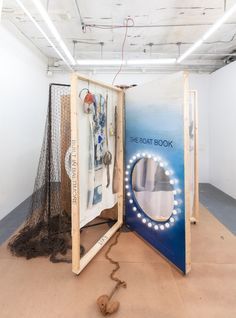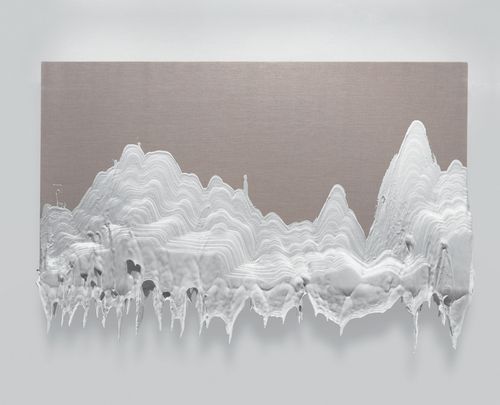Kent Shaw's Blog, page 11
December 8, 2014
"The Boat Book," by Allison Knowles [Via Pinterest]
November 26, 2014
“Untitled #1180 (Beatrice),” by Petah Coyne.
This...
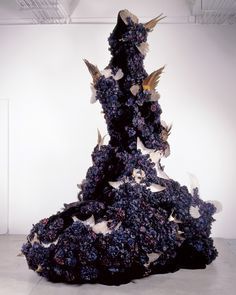
“Untitled #1180 (Beatrice),” by Petah Coyne.
This piece appears in the context of an article about birds, when birds appear in art. And I just really like how these birds in Coyne’s piece are dead. Like, really dead. Definitely dead. But what is this object / creature / organic presence that has smothered the birds? Was there some malicious wind that blew the birds into it? They all look like they lost their balance.
I was just reading this morning about nests. Specifically, I was reading Bachelard’s chapter from The Poetics of Space about nests, and how the nest evokes comfort and belonging, not just on a psychological level, but on a level of muscle memory. As animals, we fit into whatever we identify as our nest.
When I look at this object, it feels like the opposite of a nest. An anti-nest. Bachelard talks about how birds mold the insides of their nest by pressing their breast into the sides. It makes this art piece even more sinister.
"Untitled #1180 (Beatrice)," by Petah Coyne.
This piece appears...
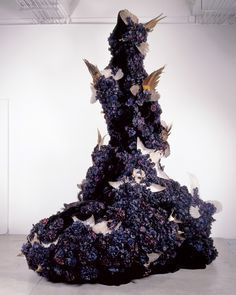
"Untitled #1180 (Beatrice)," by Petah Coyne.
This piece appears in the context of an article about birds, when birds appear in art. And I just really like how these birds in Coyne’s piece are dead. Like, really dead. Definitely dead. But what is this object / creature / organic presence that has smothered the birds? Was there some malicious wind that blew the birds into it? They all look like they lost their balance.
I was just reading this morning about nests. Specifically, I was reading Bachelard’s chapter from The Poetics of Space about nests, and how the nest evokes comfort and belonging, not just on a psychological level, but on a level of muscle memory. As animals, we fit into whatever we identify as our nest.
When I look at this object, it feels like the opposite of a nest. An anti-nest. Bachelard talks about how birds mold the insides of their nest by pressing their breast into the sides. It makes this art piece even more sinister.
November 25, 2014
I was just reading an interview with David Shrigley this...

I was just reading an interview with David Shrigley this morning, and he talked about an installation piece that would involve a gift shop in the middle of his own exhibit. All the change from the cash register would be removed and placed in a hot plate. Whenever people would buy something, the change would be flicked at them. “Too dangerous!” said the museum. Which, yeah. Maybe. Shrigley said what would be cool is you could take all the change that would be left on the ground and contribute it to charity.
That’s “WRITE POEMS” in my mind. A storefront sign. From what I can see in this photo, it looks like this exhibit is going to lead you into the elevator. “Going up!” say the spectacular poets. “Going down!” say the morose poets. And then POETRY! Or POEMS. No exclamation point for David Shrigley, because he’s just a little more understated. Maybe David Shrigley is like purgatory, where all you can eat is laffy taffy all eternity long.
David Shrigley: life and life drawing
November 9, 2014
NOTE AT THE BEGINNING: I realize I don’t know how to...
NOTE AT THE BEGINNING: I realize I don’t know how to pronounce Emily Toder’s last name. Last night when my wife and I were talking about Toder’s book, she pronounced Toder with an “awe” sound, and I pronounce it, as you can hear in the audio, with an “oh” sound. Alas.
ABOUT THE POEM: There’s a really fun feature to this poem. Namely, make everything that happens, everything the speaker has happen to her (or maybe him—the speaker can, after all, be either “leading lady” or “leading man”) happen “in my poem.” Like all the ways that this speaker is going to declare that “I am X. I am Y. I do L. I bring M.” it all happens “in my poem.” A point which would seem fairly innocuous. A point that could border on gimmick-y. But in this case, there is a bit more involved.
The “in my poem” move frames the poem as more than just language-occasion for writing. Here, poem can be seen as an actor on the scene. Meaning, the poem seems to have a way of acting on the speaker, or at least taking a conscious role in defining the setting for the speaker, so that the speaker has to react, and who wouldn’t welcome reacting to a poem that creates such favorable circumstances to be acting in or toward or to or at. I like acting! I like acting the part of this speaker! Please, poem, define the me who I am!
And, well, I would invite people to read Toder’s Science, even if you don’t know how to pronounce her last name. Because this method of definition seems to be the line moving throughout the book, especially in the “Brushes With” section, where shapes, like squares, and rhombi, and circles, and toes (I’m kidding! No toes!) all get imbued with meaning by virtue of their surroundings. Or maybe the shapes aren’t really meaning anything. They’re just being weird and sterile and abstract. And only a poem can competently make these poor shapes feel like they have a place in the material world. It brings an interesting shade to the speaker of “The Buck Stops Here.” Is he/she an abstract entity just looking for a little material to make life feel more real? Enter poem. And if tumblr let me add one more audio file, maybe I would make it “Enter Sandman,” so you could really understand what a poem is capable of.
October 1, 2014
Paint Dipper, by Roxy Paine [Via Pinterest]
September 24, 2014
“Vapor Slide,” by Soo Sunny Park. Brazed chain link...
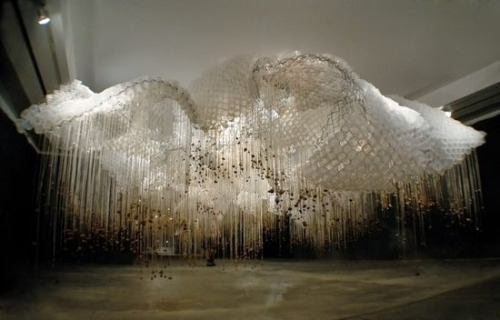
“Vapor Slide,” by Soo Sunny Park. Brazed chain link fence, plastic cups, paper clips, river rocks, cotton strings, iron oxide, latex paint, artificial light, daylight. Brazed chain link fence???? [Via Pinterest]
"Vapor Slide," by Soo Sunny Park. Brazed chain link fence,...
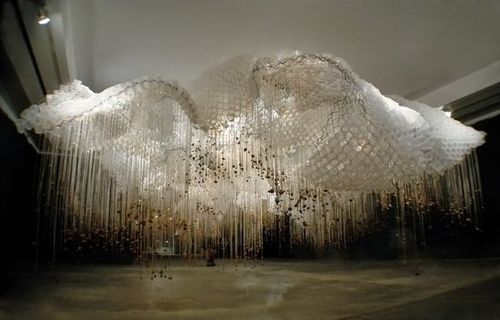
"Vapor Slide," by Soo Sunny Park. Brazed chain link fence, plastic cups, paper clips, river rocks, cotton strings, iron oxide, latex paint, artificial light, daylight. Brazed chain link fence???? [Via Pinterest]
September 18, 2014
So, yeah. If you’ve read anything I’ve written about...
So, yeah. If you’ve read anything I’ve written about poetry, you might know I’m a fan of the breathlessness. The poem that likes to ride and ride into a poetry continuum. And it’s not stopping. Don’t stop poetry continuum. I LIKE THE BREATHLESS, AND I CANNOT LIE!!
This is a breathless-ish poem from Kimberly Grey that appeared in last winter’s A Public Space. And what draws me to this poem is the combination of breathless with syntactic qualification. Which is something I’ve seen done really well in poems by Laura Eve Engel’s (many of her poems, Read this really fun one here). Maybe I’m making the term “syntactic qualification.” What does it mean? Reusing a word later in a sentence so that the original appearance of the word feels curtailed by repetition rather than amplified by repetition. There aren’t a lot of examples in this poem by Grey. Even where Grey repeats “people” about a third of the way through, the people is more anaphoric than curtailing. For me, it’s more the sensibility of Grey’s poem that reminds me of Laura Eve’s poems. I also hear it in Geoffrey G. O’Brien’s.
The sense I’m describing is like being contained in a padded intellectual chamber. Or like my consciousness is in a 1980s video game where the computer just keeps turning me 30 degrees at various intervals.
September 11, 2014
Cai Guo-Qiang, The Ninth Wave. Stuffed animals on a fishing...
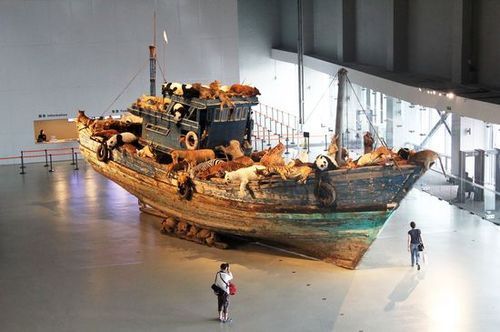
Cai Guo-Qiang, The Ninth Wave. Stuffed animals on a fishing boat. IN A POWER STATION IN SHANGHAI!! [Via Pinterest]

